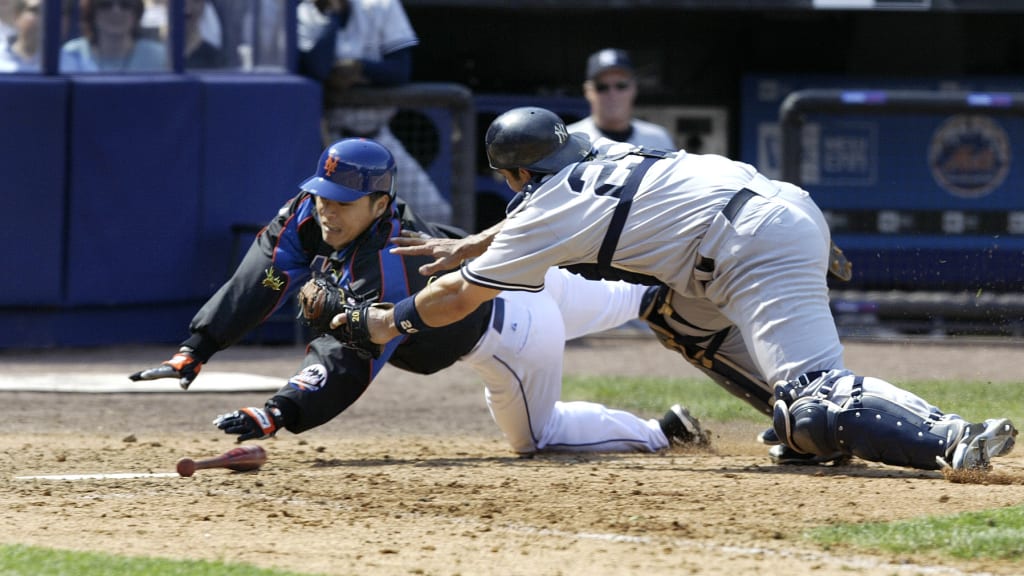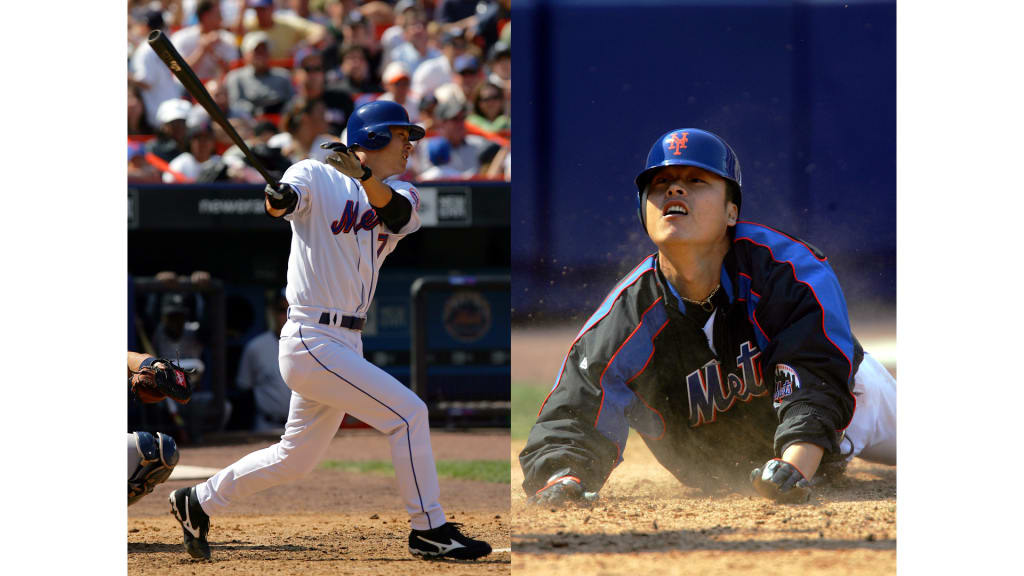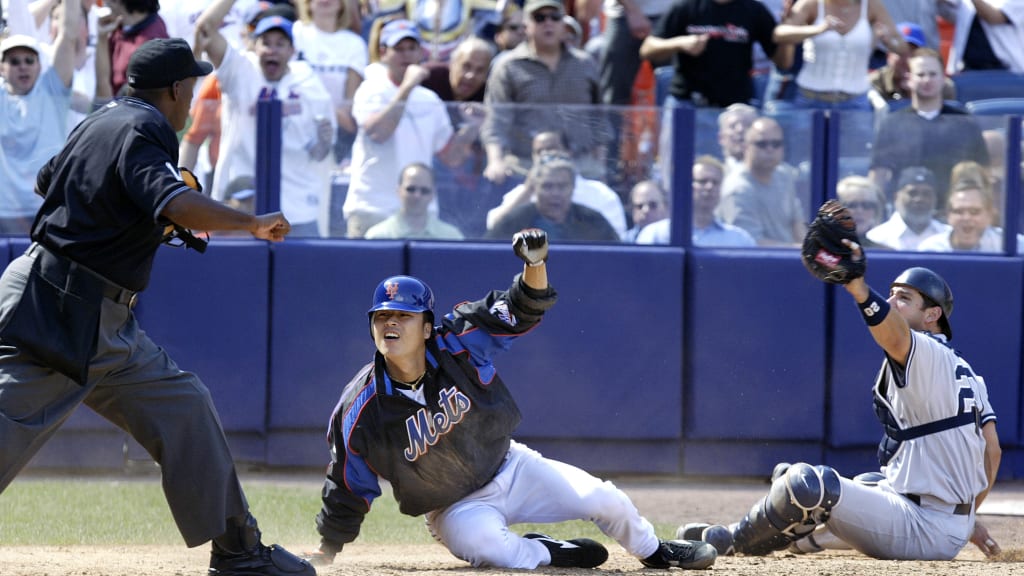A version of this story originally ran in May 2020.
Mets fans have to believe in miracles. Miraculous season? They have the 1969 Miracle Mets. Miraculous game? Game 6 in 1986. Miraculous moment? Bartolo's home run.
But how about a miraculous series of events -- one so impossible, you'll never see anything like it again. The Mets have that, too ... thanks to the one and only Mr. Koo.
On May 21, 2005, Dae-Sung Koo became a Mets legend. In a Subway Series game at Shea Stadium, 55,800 fans bore witness to one of the greatest escapades in the history of the New York rivalry. The 35-year-old Korean relief pitcher, crushed a double off Randy Johnson (sending David Wright into hysterics in the dugout) … then scored from second base on a bunt by José Reyes, diving past Jorge Posada as the catcher scrambled back to an uncovered plate.
Sure, Posada might have tagged Koo before he touched the plate. Heck, Koo might not have touched the plate at all. But those are mere trivialities. Umpire Chuck Meriwether called Koo safe, and that's all that matters. Take it from Mr. Koo himself: "I think he made the right call. … If he said 'Safe,' then I'm safe."
Looking back, the whole thing still stretches the boundaries of belief. Here are five reasons why Mr. Koo's double and mad dash home might be the unlikeliest sequence you'll ever see on a baseball field.

1) Mr. Koo was the world's most reluctant batter
Koo spent exactly one season in Major League Baseball. He took exactly two at-bats for the Mets. Randy Johnson was at-bat No. 2, and Koo's shining moment wouldn't have been so amazing if not for what happened earlier in the week in at-bat No. 1 against the Reds' Todd Coffey. Koo stood on the very edge of the batter's box ("20 feet away from the plate," Cliff Floyd joked), watched three strikes go by and escaped to the dugout.
Who knew Koo was only setting the stage. Five days later, the stars aligned for him to bat again. Despite the comedy of the first at-bat, Mets manager Willie Randolph let Koo hit for himself against the Big Unit, because he wanted the lefty specialist Koo to face then rookie Robinson Canó leading off the next inning.
In the Mets dugout, Mike Piazza promised he'd donate a million dollars to charity if Koo got a hit. In the announcing booth, Tim McCarver said to Joe Buck, "I'm just gonna go out on a limb and say that, thus far in this young season, this is the biggest give-up at-bat." The sentence wasn't even fully out of his mouth when Koo turned on a Johnson fastball and launched it way over Bernie Williams' head to the center-field warning track, just in front of the Shea home run apple, prompting Buck to let out a cry of gleeful disbelief.
"It never came to my mind that I could hit a ball that far," Koo would say after the game. It was the first hit he'd gotten since high school.
As Randolph put it, "He pulled the old okey-doke."
2) This was Randy Johnson. Against a pitcher
It's spectacular irony that Koo would barely stand in against Todd Coffey but hammered a double off a Hall of Fame pitcher with 4,875 career strikeouts.
Think about this: there were 534 plate appearances by pitchers against Johnson in his career. He finished off 261 of them, nearly half, with strikeouts. Pitchers had a .106 batting average against him. In 22 years, he allowed only 11 extra-base hits.
Eleven extra-base hits in 534 plate appearances. That's 2%. Oh, and three of those came in Johnson's final season, when he was 45 years old. Entering the fateful day that Johnson faced Koo, pitchers only had six extra-base hits in 417 plate appearances against him.
"I’m laughing now, so I can’t imagine what I was doing when I was 22 years old," Wright recalled to the New York Post's Ken Davidoff in 2018. "I wonder what the odds were of him getting a hit off Randy Johnson in that situation? Pretty astronomical."
3) And not just a pitcher. A lefty pitcher
This was more than just a pitcher hitting against Randy. This was a lefty-lefty matchup against maybe the most dominant, intimidating left-handed pitcher of all time. That makes Koo's double even crazier.
Koo was one of 52 different left-handed-hitting pitchers who got the "privilege" of facing Johnson, for a total of 154 plate appearances. Only 12 of those plate appearances ended in a hit, period. And an extra-base hit? Now you're down to three: two doubles in the same game in 2004 by Jason Jennings, who was one of the best hitting pitchers of his time; and Mr. Koo.
Yes, Koo was one of just two lefty-swinging pitchers ever to double off the great Randy Johnson. The Big Unit brought out the best in Mr. Koo.
"Randy Johnson is very famous in Korea," Koo said. "He’s well-known all over the world. I was really going up there thinking of who I had to face."

4) No one scores from second on bunts
But remember, Koo doubling off Johnson was only the beginning. His daredevil baserunning play was just as unlikely, if not even more so. A runner almost never scores from second on a bunt. Not clean, not without the help of an error.
Let's look at the 20 MLB seasons from 2000-19. Over that time, there were 4,915 successful sacrifice bunts under the same baserunning condition as Mr. Koo's, a lone runner on second, as catalogued by Baseball Reference's Play Index.
Here's how many times the runner scored cleanly on one of those sac bunts, giving the bunter a prized RBI for his stat sheet: Six. Six times in nearly 5,000. Five plus Koo.
"We were all dumbfounded," Piazza said.
"I've never seen anything like that in my life, and I probably never will again," said Doug Mientkiewicz.
"We were in shock," Wright said. "We didn't know what to say."
And Koo? "I thought I could make it."

5) Let alone someone like Mr. Koo
Who were the five other bold baserunners besides Mr. Koo?
There was Eddie Rosario on Sept. 5, 2016, who scored when the Royals forgot to cover home, in the same way Koo did. There was Rajai Davis on Aug. 5, 2012, who was running on the pitch and never stopped as he rounded third base. There was John McDonald on Sept. 18, 2010, who hustled home when Red Sox catcher Jarrod Saltalamacchia tried to wait for Jose Molina's bunt to roll foul, only for it to settle squarely on the first-base line. There was Vlad Guerrero, whose hyper-aggressive nature paid off when he scored on a sac bunt by another Molina brother, Bengie, a few months after Koo on Sept. 9, 2005. And there was Chris Singleton, who victimized a young Bartolo Colon all the way back on Sept. 10, 2001.
You might notice that none of those five were pitchers. They certainly weren't wearing a warmup jacket with a weighted ball still in the pocket, like Mr. Koo, which he landed on when he slid headfirst into home, leaving him rubbing his leg and grimacing a theatrical "Owww" as Mientkiewicz fanned him with a towel and he proceeded through a dugout high-five line.
Combine everything -- the double, the dash, the circumstances, the players involved -- and Mr. Koo truly stands alone.
